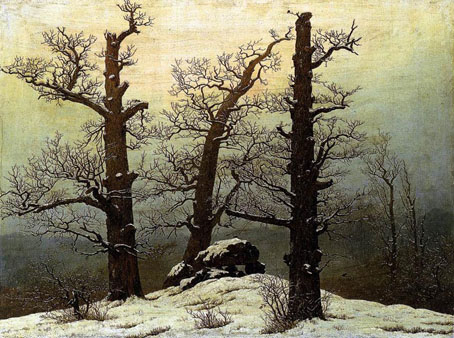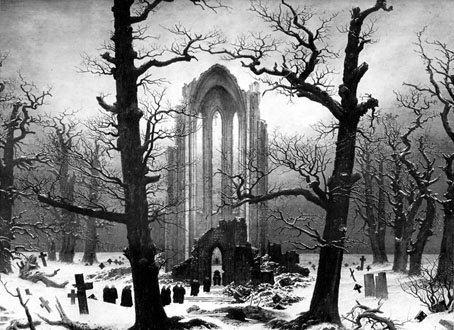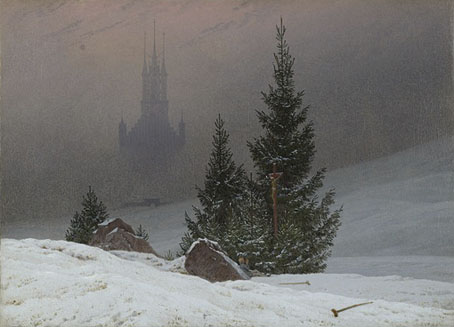Dolmen in the Snow (1807).
Some paintings for the Winter Solstice by one of my favourite Romantic artists, Caspar David Friedrich (1774–1840). Snow scenes tend to inspire picturesque cliché but in Friedrich’s paintings winter is merely another season in which to evoke his Christian mysticism through the depiction of landscape. The pagan dolmen above is an unusual subject, far more common are churchyard ruins and mountainside crosses although he was also happy enough painting luminous landscapes, especially of mountains and the sea. His treatment of natural light is quite extraordinary and his photo-realist style makes an interesting contrast with the similar effects captured by JMW Turner‘s palette of blurs and smears.
Monastery Graveyard in the Snow (1819).
I hadn’t noticed before until I looked through some online galleries that Friedrich was painting the same trees over and over. The gnarled trunks in the dolmen painting are almost identical (but reversed) to the foreground trees in the graveyard picture and similarly-shaped trees occur in other paintings. If you’re wondering why the graveyard picture is in black and white, the original was destroyed during the Second World War. Colour copies can be found but I think these may have been tinted from a monochrome photo print.
Winter Landscape (1811).
Previously on { feuilleton }
• Winter Solstice
• The art of John Atkinson Grimshaw, 1836–1893
• The art of Karl Friedrich Schinkel, 1781–1841




I’d guess the first picture is a representation of Golgotha, with the dolmen representing a weeping Mary. The tree that she’s facing on the left is is more cruciform and the others symbolise the two thieves – one upright and one bending away from the Nazarene.
Thanks Dave, that’s a good possibility given the way so many of Friedrich’s paintings are deliberately metaphorical. Rather than Mary being represented, the trees could simply depict the three crosses with the dolmen standing for the skulls of Golgotha. That doesn’t explain why the central tree is leaning, however…
I’d never seen the last painting, Winter Landscape (1811). Thank you.
I don’t think I’d seen it before until I went searching. Seems to be one of the few works of his which exists in two almost identical versions. The one here is in the National Gallery, London, but it wasn’t on display last time I was there.
I’m a long-time Friedrich fan. Great post!